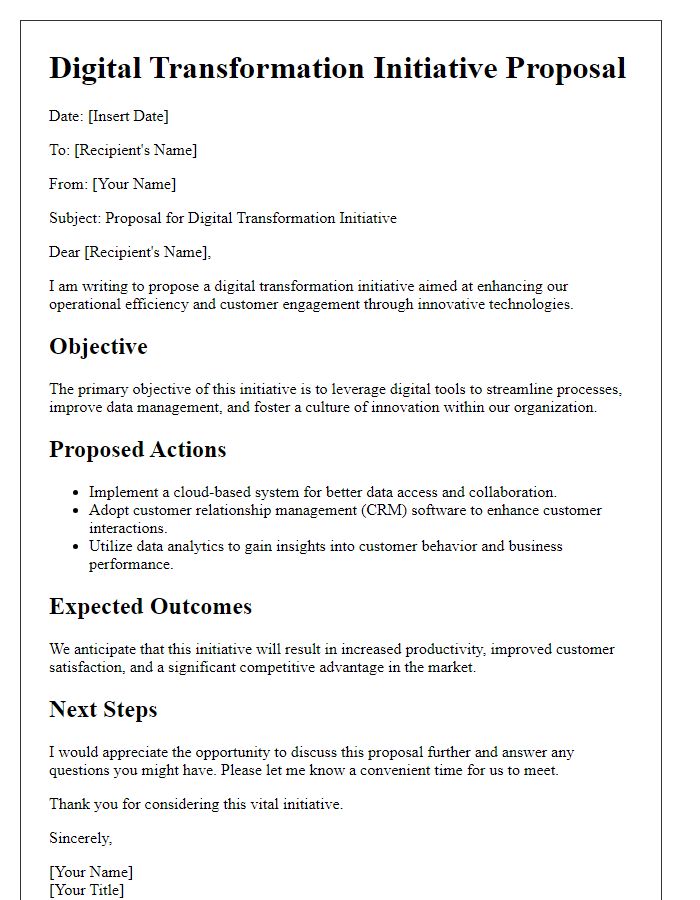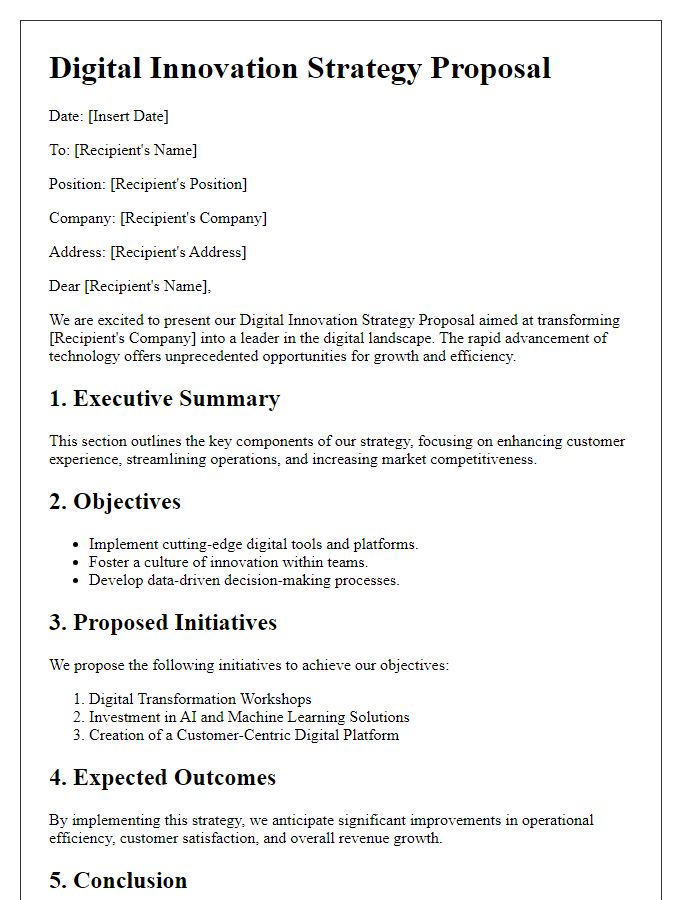Transforming your business through digital innovation is no longer an option; it's a necessity in today's fast-paced market. Our proposal is designed to guide you step-by-step through this exciting journey, empowering you to leverage technology to enhance efficiency, customer satisfaction, and competitive edge. We understand that each organization is unique, and our tailored solutions reflect that individuality, ensuring a seamless integration into your established systems. Ready to discover how we can help your business thrive in the digital age? Keep reading to learn more!

Clear Objective Statement
The objective of the digital transformation initiative is to enhance operational efficiency and improve customer engagement through the integration of advanced technologies such as artificial intelligence (AI), cloud computing, and data analytics. This initiative aims to streamline business processes, reduce operational costs by 20% within the next two years, and elevate customer satisfaction scores by 30% through personalized services. By adopting a scalable digital infrastructure, the organization seeks to foster innovation and agility, enabling it to swiftly adapt to market trends and consumer preferences in an increasingly competitive landscape. Key performance indicators (KPIs) will include time-to-market for new products, employee productivity metrics, and overall profitability growth. The initiative is projected to be implemented across all departments, including marketing, product development, and customer service, with a targeted launch date of January 2025.
Detailed Project Scope
Digital transformation initiatives often encompass various aspects of technology adoption and process enhancement within organizations. This project scope outlines the implementation of cloud computing solutions, specifically utilizing Amazon Web Services (AWS) to facilitate data management and operational efficiencies. The project intends to migrate existing on-premise systems within a medium-sized enterprise based in San Francisco, California, impacting approximately 200 employees. Key milestones include defining current system architecture, estimating migration timelines (anticipated between Q1 and Q3 of 2024), and ensuring compliance with the General Data Protection Regulation (GDPR) affecting all customer data handling processes. The scope also addresses training programs for staff to adapt to new digital tools, improving overall productivity by at least 30% according to projected metrics. Additional components will include integrating customer relationship management (CRM) systems, enhancing communication via collaboration tools like Slack or Microsoft Teams, and implementing advanced analytics for actionable insights derived from big data.
Strategic Benefits and ROI
Digital transformation initiatives can create substantial strategic benefits for organizations, enhancing efficiency and competitiveness in a rapidly evolving market. Implementing cloud-based solutions, for instance, can reduce operational costs by 25% over three years, as evidenced in case studies from leading tech companies like Microsoft and Amazon. Integrating Internet of Things (IoT) technologies can improve data collection and analytics, leading to a potential 15% increase in revenue through better customer insights and targeted marketing strategies. Investing in advanced cybersecurity measures is essential, as cyberattacks can cost businesses an average of $3.86 million per incident. The return on investment (ROI) for digital transformation is not just financial; it encompasses improved customer experiences and enhanced employee engagement, ultimately driving sustainable growth and resilience in volatile markets.
Proposed Technologies and Solutions
Emerging technologies are revolutionizing business operations by enhancing efficiency and customer engagement across industries. Artificial Intelligence (AI) platforms, such as IBM Watson, can optimize decision-making processes through machine learning and predictive analytics, providing actionable insights from vast datasets. Cloud computing systems, like Amazon Web Services (AWS), enable scalable data storage and real-time collaboration, significantly reducing infrastructure costs. Furthermore, Internet of Things (IoT) devices, including smart sensors, facilitate real-time monitoring in manufacturing sectors, improving operational workflows. Blockchain technology, exemplified by Ethereum, ensures secure transactions and enhances transparency within supply chains. Together, these digital solutions foster innovation, streamline processes, and create a customer-centric environment, essential for competitiveness in today's market.
Implementation Timeline and Milestones
The implementation timeline for digital transformation projects is critical for successfully achieving strategic goals within organizations. Phases include initial assessment (conducted during Q1 2023), setting clear objectives (established by end of Q1 2023), and technology selection (finalized by Q2 2023). Start of development and integration occurs in Q3 2023, followed by testing phases throughout Q4 2023. User training sessions are scheduled for early Q1 2024, and full deployment is targeted for end of Q1 2024. Milestones include completion of the assessment report, approval of technology stack, successful integration of systems, and user adoption rates surpassing 75% by Q2 2024. Each milestone serves as a checkpoint to measure progress and adjust strategies accordingly.













Comments